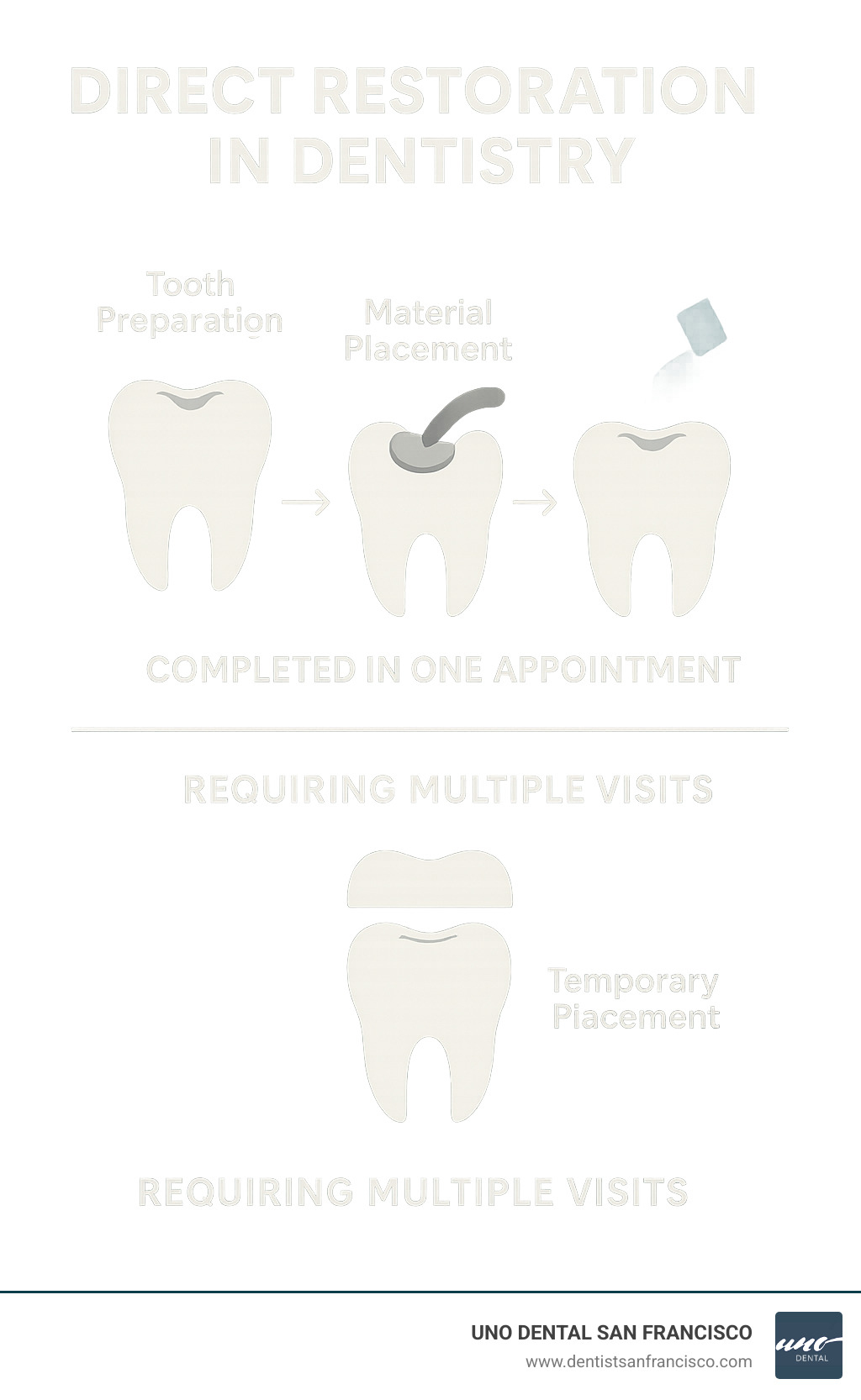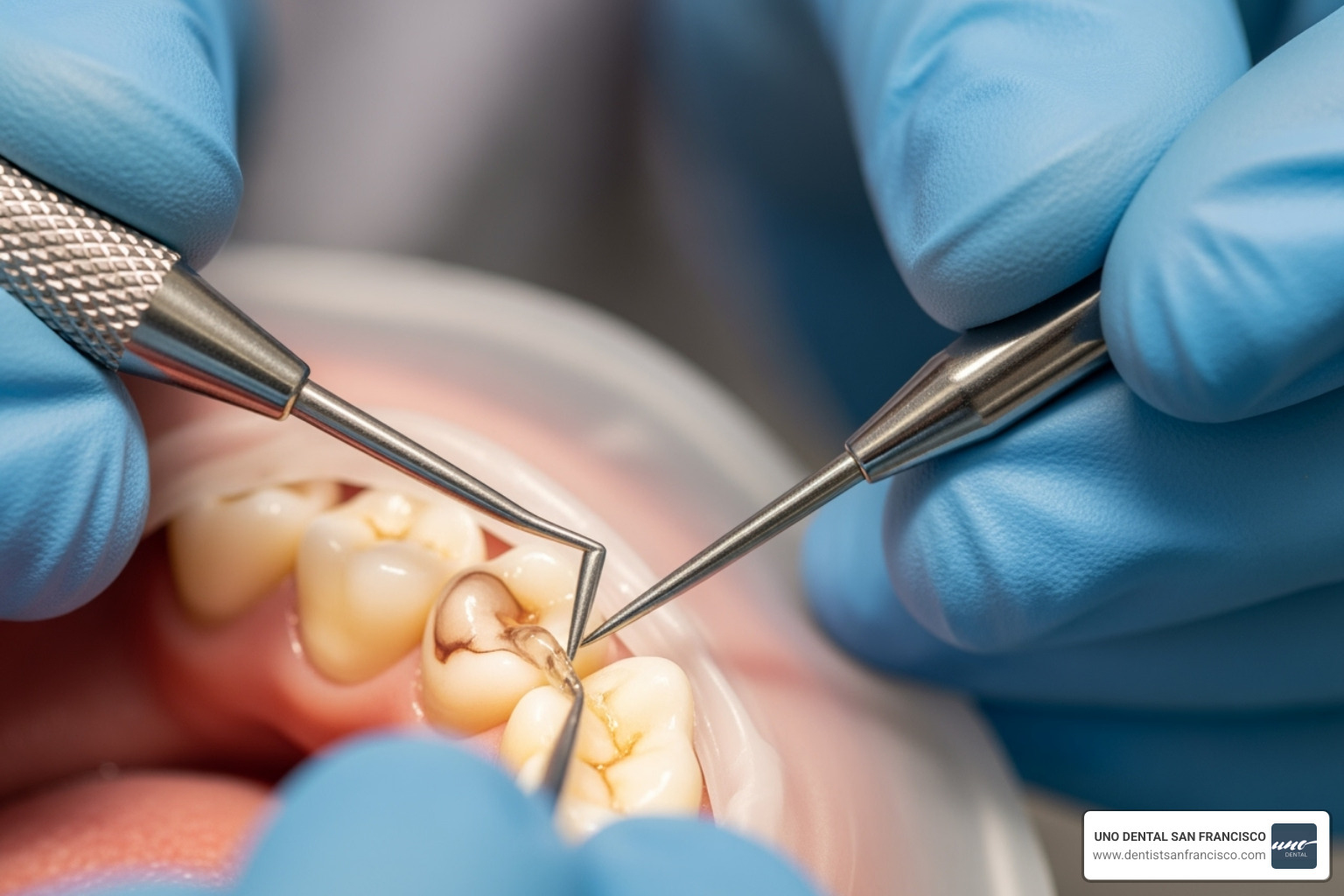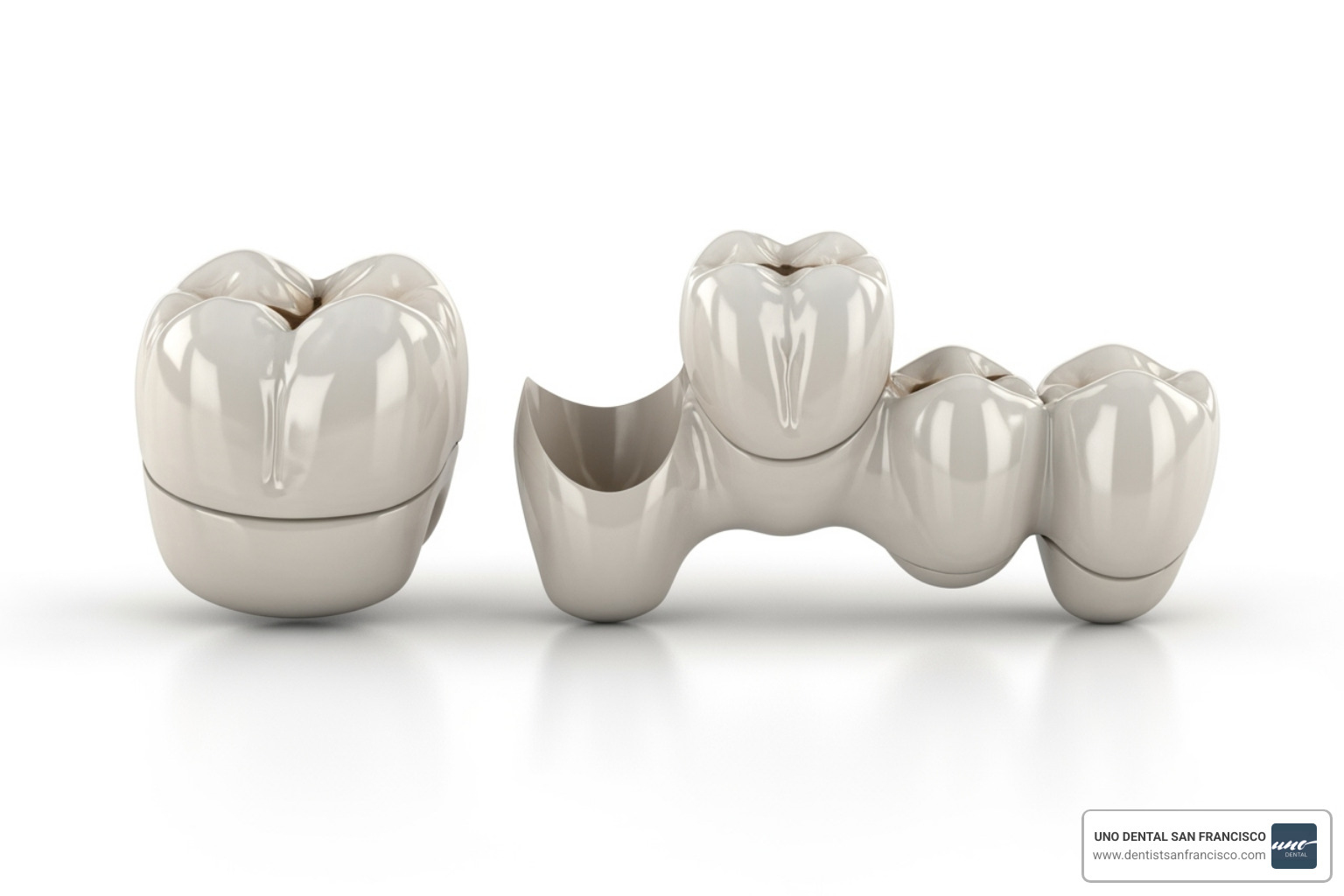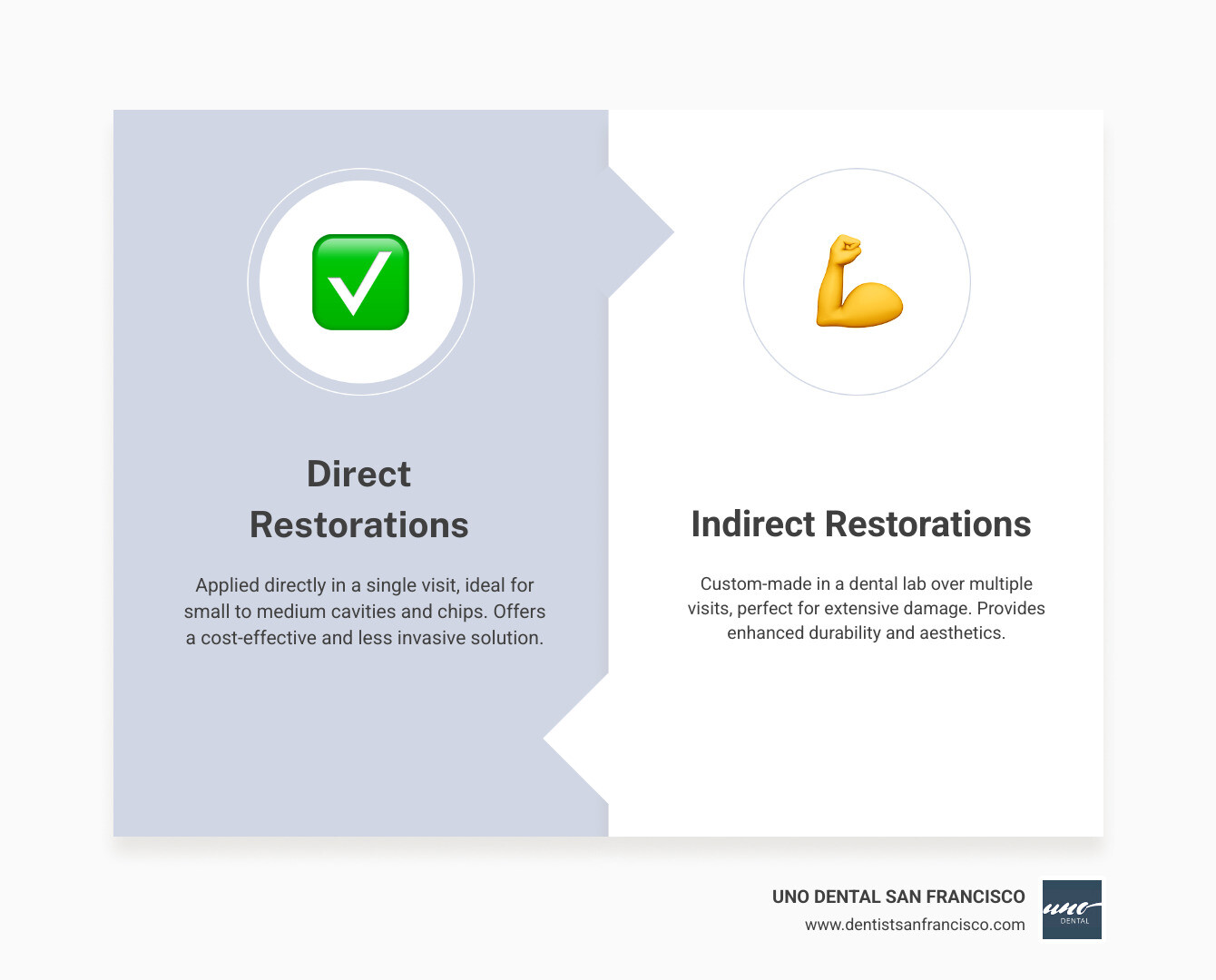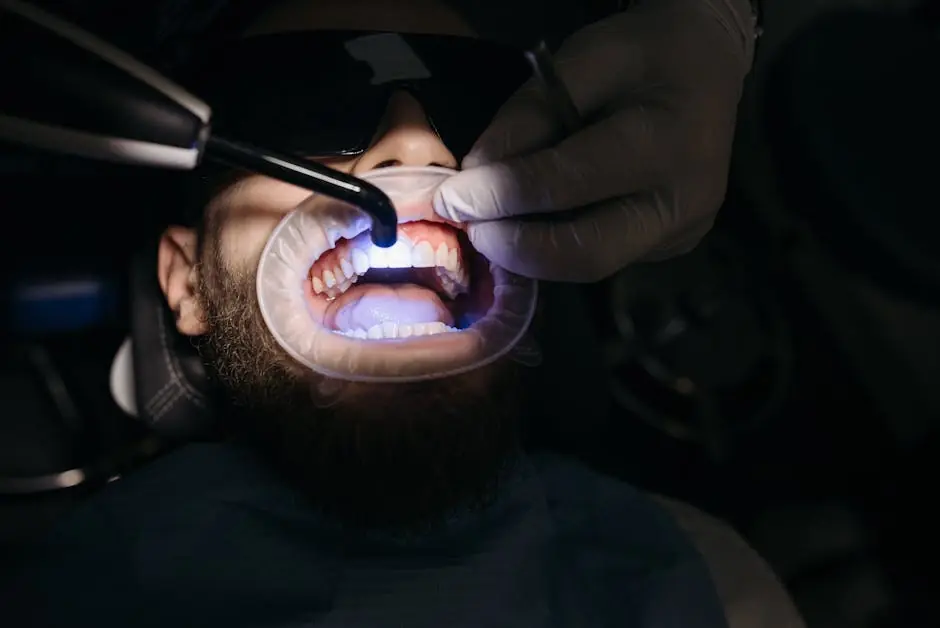
Why Understanding Your Dental Restoration Options Matters
What is a direct restoration in dentistry is a dental procedure that can be completed entirely within your mouth during a single office visit. Unlike indirect restorations that require laboratory work, direct restorations use malleable materials like composite resin that are shaped, hardened with a curing light, and polished to match your natural teeth.
Quick Answer: Direct Restoration Basics
- Definition: Restorations fabricated and completed inside the mouth in one appointment
- Common types: Composite fillings, dental bonding, some ceramic fillings
- Materials: Composite resin, amalgam, glass ionomer
- Duration: Typically 30-60 minutes per tooth
- Best for: Small to medium cavities, minor chips and cracks
When your tooth suffers damage from decay, chips, or cracks, you need a restoration to bring back its strength and function. The choice between direct and indirect restorations can feel overwhelming, especially when you're balancing time constraints with quality care.
Direct restorations offer the convenience of same-day treatment, while indirect restorations like crowns and bridges require multiple visits but often provide greater durability for extensive damage.
As Mohammad Aghiad Kandar DDS at UNO DENTAL SAN FRANCISCO, I've helped countless patients understand what is a direct restoration in dentistry and determine the best treatment approach for their unique needs. With over 15 years of experience in restorative dentistry, I've seen how the right restoration choice can transform both function and confidence in a single visit.
Find more about what is a direct restoration in dentistry:
What is a Direct Restoration in Dentistry?
What is a direct restoration in dentistry? Simply put, it's a dental repair that happens entirely in your mouth during a single visit. Think of it as the "express lane" of dental care – we fix your tooth right there in the chair, without sending anything to a lab or making you wait weeks for results.
The beauty of direct restorations lies in their immediacy. When you have a cavity or a small chip, we can clean out the damaged area and fill it with a malleable material that hardens right in your mouth. It's like watching a skilled artist sculpt your tooth back to its original shape, but with modern dental materials and a special curing light that makes everything set perfectly.
At UNO DENTAL SAN FRANCISCO, we love direct restorations because they respect your busy schedule. No multiple appointments, no temporary fillings, and no waiting around with a sore tooth. You walk in with a problem and leave with a solution – all in about an hour.
The most common types include dental fillings and dental bonding. Whether it's a small cavity from too much coffee or a chip from that popcorn kernel that fought back, direct restorations can handle these everyday dental challenges with ease.
Learn more about our direct restoration services
The Procedure: What to Expect in a Single Appointment
Walking into our San Francisco office for a direct restoration is refreshingly straightforward. We start with tooth preparation, which sounds scarier than it is. After making sure you're comfortable with local anesthetic, we gently remove any decayed or damaged parts of your tooth. Think of it as clearing away the old to make room for the new.
Next comes decay removal – we're thorough but conservative, always saving as much of your natural tooth as possible. It's like renovating a house; we only remove what's truly damaged and preserve everything healthy.
The exciting part is material placement. We use a layering technique with composite resin, building up your tooth in small layers. Each layer gets shaped and then hardened with our blue light curing device. This special light triggers a chemical reaction that turns the soft, putty-like material into something as strong as your natural tooth.
The shaping and polishing phase is where artistry meets science. We carefully sculpt the material to match your tooth's natural contours, checking your bite to ensure everything feels just right. The final polish gives your restoration that smooth, natural finish that makes it virtually invisible.
The whole process typically takes 30 to 60 minutes per tooth. You'll be amazed at how quickly we can transform a damaged tooth into something that looks and feels completely natural.
Find out more about what to expect during your dental filling appointment
Common Materials Used for Direct Restorations
Choosing the right material for your direct restoration is crucial, and we have several excellent options at UNO DENTAL SAN FRANCISCO. Each has its own personality and best-use scenarios.
Composite resin is our most popular choice, especially for visible teeth. These tooth-colored restorations blend seamlessly with your natural teeth, making them perfect for front teeth or anywhere aesthetics matter. They bond directly to your tooth structure, which actually helps strengthen the remaining tooth. The downside? They typically last 5-7 years and can pick up stains from coffee or red wine over time.
Amalgam fillings might look old-school with their silver color, but they're incredibly tough. These workhorses can last 20+ years and handle serious chewing forces without breaking a sweat. They're ideal for back teeth where strength matters more than appearance. However, their metallic look and temporary temperature sensitivity after placement make them less popular than they once were.
Ceramic options offer the best of both worlds – excellent aesthetics and stain resistance. With our advanced in-office technology, we can sometimes place ceramic restorations directly. They're biocompatible and durable, though they can be more brittle than other options and typically cost more.
Glass ionomer materials have a special superpower – they release fluoride to help protect your tooth from future decay. We often use these for small cavities, especially in children's teeth or for root surface restorations. While not as strong as composite or amalgam, they're gentle and protective.
During your consultation, we'll discuss which material makes the most sense for your specific situation, considering factors like location, aesthetics, durability needs, and budget.
Explore the different types of dental fillings we offer
Understanding Indirect Restorations
When what is a direct restoration in dentistry isn't quite enough to handle extensive damage, we turn to indirect dental restorations. Think of these as the custom-custom suits of the dental world – they require more time and craftsmanship, but the results are worth the wait.
Unlike direct restorations that are completed in your mouth during a single visit, indirect restorations are crafted outside your mouth – either in a specialized dental laboratory or using advanced in-office milling technology. This multi-visit procedure allows us to create stronger, more precise restorations that can handle significant damage or replace missing tooth structure entirely.
The beauty of indirect restorations lies in their versatility and durability. Crowns act like protective caps, completely covering a damaged tooth to restore its strength and appearance – perfect for teeth that have suffered extensive decay or fracture. Bridges neatly span the gap left by missing teeth, using neighboring teeth as anchors to support artificial replacement teeth.
For those situations where a regular filling is too small but a crown is too much, we have inlays and onlays. These precision-crafted restorations fit like puzzle pieces into the damaged area of your tooth. Veneers work their magic on the front surfaces of teeth, changing smiles with thin, custom-made shells that look incredibly natural.
The process typically unfolds over two appointments. During your first visit, we prepare the tooth and take detailed impressions or digital scans. While the dental laboratory crafts your permanent restoration, we'll place a temporary restoration to protect your tooth – usually for about 1-2 weeks.
Here's where technology gets exciting: our CAD/CAM technology and in-office milling capabilities mean that some indirect restorations can actually be completed in a single day. This advanced system allows us to design, mill, and place certain crowns and inlays during one appointment, giving you the durability of an indirect restoration with the convenience of direct treatment.
At UNO DENTAL SAN FRANCISCO, we've invested in this cutting-edge technology because we understand that your time is valuable, and waiting weeks for a restoration isn't always practical in our busy San Francisco lifestyle.
The Head-to-Head Comparison: Direct vs. Indirect
Choosing between a direct restoration and an indirect one can feel like standing in the cereal aisle – there are so many options, and they all seem good! At UNO DENTAL SAN FRANCISCO, we love helping our patients cut through the confusion and find the perfect solution for their unique smile.
The truth is, both approaches have their sweet spots. Direct restorations shine when you need something fixed quickly and efficiently, while indirect restorations are the heavy-duty champions for more extensive damage. Think of it as choosing between a quick touch-up and a complete makeover – both can transform your smile, but in different ways.
Here's how they stack up:
| Feature | Direct Restoration | Indirect Restoration |
|---|---|---|
| Number of visits | Single appointment (30-60 minutes) | Multiple visits (2-3 weeks total) |
| Cost | Generally lower upfront cost | Higher initial investment |
| Durability | 5-7 years (composite), 20+ years (amalgam) | 10-15+ years |
| Best for | Small to medium cavities, minor chips | Large cavities, extensive damage, crowns |
| Tooth preparation | Conservative, preserves more natural tooth | More extensive preparation required |
| Materials | Composite resin, amalgam, glass ionomer | Porcelain, zirconia, gold |
The beauty of modern dentistry is that we're not locked into one-size-fits-all solutions. Sometimes, what starts as a direct restoration candidate might benefit more from an indirect approach, and that's perfectly okay. Our goal is always to give you the best long-term outcome for your specific situation.
Time and Convenience: How Many Visits Will It Take?
Let's be honest – nobody wants to spend their entire month shuttling back and forth to the dentist's office. This is where direct restorations really shine as the convenience champions.
Direct restorations are the ultimate "get it done today" solution. We can tackle everything from start to finish in a single appointment. You walk in with a cavity or chip, and walk out with a fully restored tooth, usually within 30 to 60 minutes per tooth. No waiting around, no temporary fillings, no scheduling multiple appointments around your busy San Francisco lifestyle.
Indirect restorations take a more methodical approach. Your first visit involves preparing the tooth and taking detailed impressions. While our skilled lab technicians craft your custom restoration (typically 1-2 weeks), we'll place a temporary restoration to keep you comfortable and protected. Then you return for the final appointment where we permanently cement your custom-made restoration.
The extra time isn't wasted though – it allows for incredible precision and customization. Think of it like getting a custom-custom suit versus buying one off the rack. Both can look great, but the custom option offers that perfect fit.
Here's where technology gets exciting: with our advanced CAD/CAM systems, we can sometimes complete certain indirect restorations, such as crowns, in a single visit. It's like having the dental lab right in our office, giving you the best of both worlds.
Durability and Longevity: Which Lasts Longer?
When it comes to how long your restoration will last, several factors come into play. Your oral hygiene habits, the forces you put on your teeth, and the size of the restoration all matter.
Direct restorations offer solid performance for their intended uses. Composite fillings typically serve you well for five to seven years with proper care. They're surprisingly resilient and can handle normal chewing forces beautifully. Amalgam fillings, on the other hand, are the marathon runners of the dental world – they often last 20 years or more, especially in back teeth where their strength really shines.
Indirect restorations are built for the long haul. These custom-crafted solutions typically last 10 to 15 years, and often much longer with excellent care. The materials we use – like porcelain and zirconia – are incredibly tough and designed to withstand significant chewing pressure day after day.
The key is matching the restoration to your needs. A small cavity doesn't need a crown any more than you'd use a sledgehammer to hang a picture frame.
What is a direct restoration in dentistry best for?
Understanding what is a direct restoration in dentistry means knowing when it's your ideal choice. These restorations are perfect for several specific situations.
Small to medium cavities are where direct restorations truly excel. When we catch decay early, before it spreads extensively, a direct filling can remove the problem and restore your tooth's strength in one visit. It's dental care at its most efficient.
Minor chips and cracks respond beautifully to direct restoration techniques. Whether you bit down on something hard or had a small accident, composite bonding can seamlessly repair and reshape your tooth, often making it look better than before.
The cost-effectiveness of direct restorations makes quality dental care more accessible. They typically require a lower upfront investment compared to indirect options, which is important when you're managing your healthcare budget.
Perhaps most importantly, direct restorations allow for conservative tooth preparation. We can often preserve more of your natural tooth structure, which is always our preferred approach. At UNO DENTAL SAN FRANCISCO, we believe your natural teeth are irreplaceable, and we work hard to keep as much of them as possible.
If you're dealing with minor dental concerns and value convenience and efficiency, a direct restoration might be exactly what your smile needs.
Learn more about when to consider dental fillings
Frequently Asked Questions About Dental Restorations
We know you might have more questions about dental restorations. Here are some of the most common inquiries we receive at UNO DENTAL SAN FRANCISCO:
What are the main advantages and disadvantages of what is a direct restoration in dentistry?
Understanding the pros and cons helps in making an informed decision about what is a direct restoration in dentistry for your specific needs.
When it comes to advantages, time-saving tops the list – you walk in with a problem and walk out with a solution, often in under an hour. There's something incredibly satisfying about leaving our office with your smile completely restored in a single visit! The cost-effectiveness is another major benefit, as direct restorations generally have a lower upfront cost compared to indirect options, making quality dental care more accessible.
We also love that these procedures are less invasive, requiring minimal removal of healthy tooth structure. This conservative approach aligns perfectly with our philosophy of preserving as much of your natural tooth as possible. For composite fillings, the aesthetics are outstanding – these tooth-colored materials blend seamlessly with your natural teeth, especially important for front teeth where appearance matters most.
Plus, there's no need for temporary restorations. Since everything is completed in one visit, you won't deal with the potential discomfort or dietary restrictions that come with temporary fillings or crowns.
However, direct restorations do have some limitations. They're less durable for large areas of damage – while perfect for small to medium cavities, they may not withstand the biting forces on extensively damaged teeth. Composite materials can stain over time, particularly if you're a coffee lover or enjoy red wine regularly.
There's also something called polymerization shrinkage – as the composite resin hardens, it shrinks slightly. While modern materials and our careful techniques minimize this, it can occasionally lead to marginal gaps or sensitivity. Finally, for complex cases involving extensive damage or precise bite alignment needs, an indirect restoration often provides a superior solution.
Despite these considerations, for the right situation, direct restorations offer an excellent balance of effectiveness, convenience, and affordability.
Can a direct restoration be replaced with an indirect one later?
Absolutely! This is actually quite common and something we see regularly at our San Francisco practice. Think of it as upgrading your restoration when your needs change over time.
Several situations might lead to this transition. Worn fillings naturally wear down over the years – composite fillings typically last 5-7 years, and eventually, they may chip, wear, or develop recurrent decay around their edges. When increased damage occurs, perhaps from new decay or additional tooth fracture, the original direct restoration might no longer provide adequate protection.
Sometimes patients choose to upgrade for durability or aesthetics. For instance, you might decide to replace an older amalgam filling with a beautiful porcelain crown for improved appearance and longevity. Or maybe that small filling has served you well, but now you want something that will last 15+ years instead of needing replacement every few years.
During your regular check-ups with us, we carefully assess all your existing restorations. If we notice that a direct restoration is no longer doing its job effectively, or if the underlying tooth needs more robust protection, we'll discuss your options. This proactive approach ensures your smile stays healthy and strong for years to come.
How do I care for my dental restoration?
Caring for your dental restoration is really about treating it like your natural teeth – with just a little extra attention! The good news is that the habits that keep your restorations healthy are the same ones that benefit your entire smile.
Excellent oral hygiene forms the foundation of restoration care. Brush at least twice daily with fluoride toothpaste and floss every day, paying special attention to the areas around your restorations. These junction areas where the restoration meets your natural tooth are particularly important for preventing plaque buildup and secondary decay.
Regular dental visits are crucial – we typically recommend every six months. During these appointments, we monitor your restorations for any signs of wear, chips, or gaps, and catch any new decay early. Our professional cleanings remove stubborn plaque and tartar that home care might miss.
When it comes to your diet, avoid excessively hard foods like ice, hard candies, or unpopped popcorn kernels that can chip or crack direct restorations. Very sticky foods like caramels can potentially dislodge fillings or create unnecessary stress on your restoration.
If you grind or clench your teeth, especially at night, this puts tremendous pressure on both your restorations and natural teeth. We can create custom nightguards to protect your investment and prevent premature wear.
For those with tooth-colored composite fillings, be mindful that dark beverages like coffee, tea, and red wine can cause staining over time. While this doesn't damage the restoration, it can affect its appearance.
Following these simple guidelines will help your dental restorations serve you well for many years, keeping your smile both healthy and beautiful.
Conclusion: Making the Right Choice for Your Smile in San Francisco
Choosing between what is a direct restoration in dentistry and an indirect restoration doesn't have to feel overwhelming. Think of it like choosing the right tool for the job – both options have their perfect moments to shine, and understanding your specific needs makes all the difference.
At UNO DENTAL SAN FRANCISCO, we've seen countless patients walk through our doors feeling uncertain about their dental restoration options. What brings us joy is watching that uncertainty transform into confidence as we work together to find the perfect solution for their unique smile.
Direct restorations offer the beautiful simplicity of same-day treatment – perfect for busy San Francisco lifestyles where time is precious. They're ideal when you have smaller cavities or minor chips that need attention without the complexity of multiple appointments.
Indirect restorations provide the strength and precision needed for more extensive damage, offering long-term durability that can serve you well for decades with proper care.
The magic happens when we combine our high-tech diagnostics with a truly personalized approach to your care. Every patient who sits in our chair receives a thorough evaluation that considers not just the immediate dental concern, but your overall oral health, lifestyle, and aesthetic goals. This holistic view ensures we're recommending the restoration that will serve you best in the long run.
Our team understands that behind every dental decision is a person who wants to feel confident in their smile. Whether you're dealing with a small cavity that needs a quick composite filling or more extensive damage requiring a custom crown, we're here to guide you through every step with patience and expertise.
Professional diagnosis is absolutely essential because what looks like a simple problem might have underlying complexities, and what seems overwhelming might have a straightforward solution. That's why we emphasize thorough consultations where all your questions are answered and all your options are clearly explained.
Don't let dental concerns keep you from sharing your brightest smile with the world. We invite you to experience the personalized, compassionate care that sets UNO DENTAL SAN FRANCISCO apart, where your comfort and oral health are always our top priorities.
